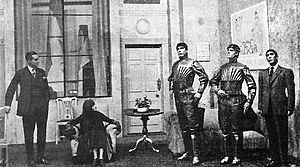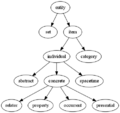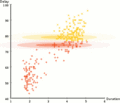Artificial intelligence facts for kids

Artificial intelligence (AI) is the ability of a computer program or a machine to think and learn. It is also a field of study which tries to make computers "smart". John McCarthy came up with the name "artificial intelligence" in 1955.
In general use, the term "artificial intelligence" means a machine which mimics human cognition. At least some of the things we associate with other minds, such as learning and problem solving can be done by computers, though not in the same way as we do.
An ideal (perfect) intelligent machine is a flexible agent which perceives its environment and takes actions to maximize its chance of success at some goal. As machines become increasingly capable, mental facilities once thought to require intelligence are removed from the definition. For example, optical character recognition is no longer perceived as an exemplar of "artificial intelligence": it is just a routine technology.
At present we use the term AI for successfully understanding human speech, competing at a high level in strategic game systems (such as Chess and Go), self-driving cars, and interpreting complex data. Some people also consider AI a danger to humanity if it progresses unabatedly.
An extreme goal of AI research is to create computer programs that can learn, solve problems, and think logically. In practice, however, most applications have picked on problems which computers can do well. Searching data bases and doing calculations are things computers do better than people. On the other hand, "perceiving its environment" in any real sense is way beyond present-day computing.
AI involves many different fields like computer science, mathematics, linguistics, psychology, neuroscience, and philosophy. Eventually researchers hope to create a "general artificial intelligence" which can solve many problems instead of focusing on just one. Researchers are also trying to create creative and emotional AI which can possibly empathize or create art. Many approaches and tools have been tried.
Contents
History
Objects that look and act like humans exist in every major civilization. The first appearance of artificial intelligence is in Greek myths, like Talos of Crete or the bronze robot of Hephaestus. Humanoid robots were built by Yan Shi, Hero of Alexandria, and Al-Jazari. Sentient machines became popular in fiction during the 19th and 20th centuries with the stories of Frankenstein and R.U.R.
Formal logic was developed by ancient Greek philosophers and mathematicians. This study of logic produced the idea of a computer in the 19th and 20th century. Mathematician Alan Turing's theory of computation said that any mathematical problem could be solved by processing 1's and 0's. Advances in neurology, information theory, and cybernetics convinced a small group of researchers that an electronic brain was possible.
AI research really started with a conference at Dartmouth College in 1956. It was a month long brainstorming session attended by many people with interests in AI. At the conference they wrote programs that were amazing at the time, beating people at checkers or solving word problems. The Department of Defense started giving a lot of money to AI research and labs were created all over the world.
Unfortunately, researchers really underestimated just how hard some problems were. The tools they had used still did not give computers things like emotions or common sense. Mathematician James Lighthill wrote a report on AI saying that "in no part of the field have discoveries made so far produced the major impact that was then promised". The U.S and British governments wanted to fund more productive projects. Funding for AI research was cut, starting an "AI winter" where little research was done.
AI research revived in the 1980s because of the popularity of expert systems, which simulated the knowledge of a human expert. By 1985, 1 billion dollars were spent on AI. New, faster computers convinced U.S and British governments to start funding AI research again. However, the market for Lisp machines collapsed in 1987 and funding was pulled again, starting an even longer AI winter.
AI revived again in the 90s and early 2000s with its use in data mining and medical diagnosis. This was possible because of faster computers and focusing on solving more specific problems. In 1997, Deep Blue became the first computer program to beat chess world champion Garry Kasparov. Faster computers, advances in deep learning, and access to more data have made AI popular throughout the world. In 2011 IBM Watson beat the top two Jeopardy! players Brad Rutter and Ken Jennings, and in 2016 Google's AlphaGo beat top Go player Lee Sedol 4 out of 5 times.
AI in governing
In March 2023, Romanian Prime Minister Nicolae Ciucă unveiled an AI-run "honorary advisor" named Ion, which will synthesize messages from Romanians related to their "opinions and desires". Ciucă says that this makes Romania the first country in the world to have an AI government advisor.
Superintelligence
A superintelligence, hyperintelligence, or superhuman intelligence, is a hypothetical agent that would possess intelligence far surpassing that of the brightest and most gifted human mind. Superintelligence may also refer to the form or degree of intelligence possessed by such an agent.
If research into artificial general intelligence produced sufficiently intelligent software, it might be able to reprogram and improve itself. The improved software would be even better at improving itself, leading to recursive self-improvement. Its intelligence would increase exponentially in an intelligence explosion and could dramatically surpass humans. Science fiction writer Vernor Vinge named this scenario the "singularity". Because it is difficult or impossible to know the limits of intelligence or the capabilities of superintelligent machines, the technological singularity is an occurrence beyond which events are unpredictable or even unfathomable.
Robot designer Hans Moravec, cyberneticist Kevin Warwick, and inventor Ray Kurzweil have predicted that humans and machines will merge in the future into cyborgs that are more capable and powerful than either. This idea, called transhumanism, has roots in Aldous Huxley and Robert Ettinger.
Edward Fredkin argues that "artificial intelligence is the next stage in evolution", an idea first proposed by Samuel Butler's "Darwin among the Machines" as far back as 1863, and expanded upon by George Dyson in his book of the same name in 1998.
Risks
Technological unemployment
In the past, technology has tended to increase rather than reduce total employment, but economists acknowledge that "we're in uncharted territory" with AI.
Unlike previous waves of automation, many middle-class jobs may be eliminated by artificial intelligence; The Economist states that "the worry that AI could do to white-collar jobs what steam power did to blue-collar ones during the Industrial Revolution" is "worth taking seriously". Jobs at extreme risk range from paralegals to fast food cooks, while job demand is likely to increase for care-related professions ranging from personal healthcare to the clergy. Michael Osborne and Carl Benedikt Frey estimate 47% of U.S. jobs are at "high risk" of potential automation, while an OECD report classifies only 9% of U.S. jobs as "high risk".
Bad actors and weaponized AI
AI provides a number of tools that are particularly useful for authoritarian governments: smart spyware, face recognition and voice recognition allow widespread surveillance; such surveillance allows machine learning to classify potential enemies of the state and can prevent them from hiding; recommendation systems can precisely target propaganda and misinformation for maximum effect; deepfakes aid in producing misinformation; advanced AI can make centralized decision making more competitive with liberal and decentralized systems such as markets.
Terrorists, criminals and rogue states may use other forms of weaponized AI such as advanced digital warfare and lethal autonomous weapons. By 2015, over fifty countries were reported to be researching battlefield robots.
Machine-learning AI is also able to design tens of thousands of toxic molecules in a matter of hours.
Algorithmic bias
AI programs can become biased after learning from real-world data. It is not typically introduced by the system designers but is learned by the program, and thus the programmers are often unaware that the bias exists.
Existential risk
Superintelligent AI may be able to improve itself to the point that humans could not control it. This could, as physicist Stephen Hawking puts it, "spell the end of the human race". Philosopher Nick Bostrom argues that sufficiently intelligent AI, if it chooses actions based on achieving some goal, will acquire resources to protect itself from being shut down. If this AI's goals do not fully reflect humanity's, it might need to harm humanity to acquire more resources or prevent itself from being shut down, ultimately to better achieve its goal. He concludes that AI poses a risk to mankind, however humble or "friendly" its stated goals might be.
Stephen Hawking, Microsoft founder Bill Gates, history professor Yuval Noah Harari, and SpaceX founder Elon Musk have all expressed serious misgivings about the future of AI. Mark Zuckerberg (CEO, Facebook) has said that artificial intelligence is helpful in its current form and will continue to assist humans.
Other experts argue is that the risks are far enough in the future to not be worth researching, or that humans will be valuable from the perspective of a superintelligent machine. Rodney Brooks, in particular, has said that "malevolent" AI is still centuries away.
Copyright
AI's decisions making abilities raises the questions of legal responsibility and copyright status of created works. This issues are being refined in various jurisdictions. However, criticism has been raised about whether and to what extent the works created with the assistance of AI are under the protection of copyright laws.
Ethical machines
Friendly AI are machines that have been designed from the beginning to minimize risks and to make choices that benefit humans. Eliezer Yudkowsky, who coined the term, argues that developing friendly AI should be a higher research priority: it may require a large investment and it must be completed before AI becomes an existential risk.
Machines with intelligence have the potential to use their intelligence to make ethical decisions. Machine ethics is also called machine morality, computational ethics or computational morality, and was founded at an AAAI symposium in 2005.
In fiction

Thought-capable artificial beings have appeared as storytelling devices since antiquity, and have been a persistent theme in science fiction.
A common trope in these works began with Mary Shelley's Frankenstein, where a human creation becomes a threat to its masters. This includes such works as Arthur C. Clarke's and Stanley Kubrick's 2001: A Space Odyssey (both 1968), with HAL 9000, the murderous computer in charge of the Discovery One spaceship, as well as The Terminator (1984) and The Matrix (1999). In contrast, the rare loyal robots such as Gort from The Day the Earth Stood Still (1951) and Bishop from Aliens (1986) are less prominent in popular culture.
Isaac Asimov introduced the Three Laws of Robotics in many books and stories, most notably the "Multivac" series about a super-intelligent computer of the same name.
Transhumanism (the merging of humans and machines) is explored in the manga Ghost in the Shell and the science-fiction series Dune.
Several works use AI to force us to confront the fundamental question of what makes us human, showing us artificial beings that have the ability to feel, and thus to suffer. This appears in Karel Čapek's R.U.R., the films A.I. Artificial Intelligence and Ex Machina, as well as the novel Do Androids Dream of Electric Sheep?, by Philip K. Dick. Dick considers the idea that our understanding of human subjectivity is altered by technology created with artificial intelligence.
Images for kids
-
A particle swarm seeking the global minimum
-
Expectation-maximization clustering of Old Faithful eruption data starts from a random guess but then successfully converges on an accurate clustering of the two physically distinct modes of eruption.
-
For this project the AI had to learn the typical patterns in the colors and brushstrokes of Renaissance painter Raphael. The portrait shows the face of the actress Ornella Muti, "painted" by AI in the style of Raphael.
-
AI Patent families for functional application categories and sub categories. Computer vision represents 49 percent of patent families related to a functional application in 2016.
Related pages
- Fuzzy logic
- Bayesian network
- Neural networks
- Expert systems
- Machine learning
- Technological singularity
See also
 In Spanish: Inteligencia artificial para niños
In Spanish: Inteligencia artificial para niños








